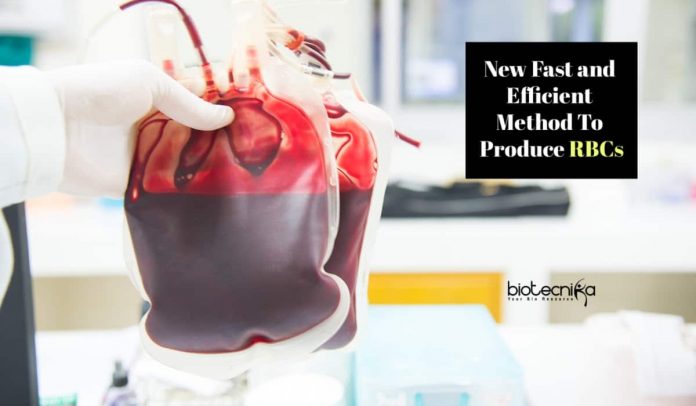A new method to manufacture human red blood cells (RBCs) has been developed by researchers from MIT’s research enterprise in Singapore, Singapore-MIT Alliance for Research and Technology (SMART). Compared to existing methods, the new method cuts the culture time by half and uses less costly, more precise, and faster methods for sorting and purification.
Millions of lives are saved every year by blood transfusions. But more than half of the countries in the world do not have enough blood supply to meet their needs. For those in need of transfusions for conditions like leukemia, the ability to manufacture RBCs on demand, especially the universal donor blood (O+), will be of great benefit.
Manufacturing RBCs will reduce the dependence on donor blood, which has a higher risk of infection and will have a significant impact on blood banks worldwide. It can also help in developing new and improved cell therapies critical for malaria research, a disease that affects over 220 million people annually.
The current manufacturing methods for RBCs are time-consuming and produce undesirable by-products, purification of which is costly and not optimal for large scale therapeutic applications.
So an optimized intermediary cryogenic storage protocol has been designed by SMART’s researchers
, which reduces the cell culture time from 23 days to just 11 days. Complementary technologies for low-cost and highly efficient RBC purification and more targeted sorting were also developed by the researchers to aid the process.The paper recently published in Lab on a Chip explains the huge technical advancements they have made towards improving methods for RBC manufacturing.
The lead author of the paper, Dr. Kerwin Kwek, said they optimized the protocol for storing the cells in liquid nitrogen on Day 12 of the process, which can be later thawed upon demand and used to produce RBCs in just 11 days.
By modifying existing Deterministic Lateral Displacement (DLD) and Dean Flow Fractionation (DFF), they also developed novel sorting and purification methods, a unique sorting system achieved with an inverse L-shape pillar structure for DLD sorting and a trapezoidal cross-section design and microfluidic chip for DFF sorting.
Instead of spherical size, RBC’s deformability and size are leveraged for purification by the purification and sorting techniques. This technique can have a range of clinical and biological applications in immune cell and cancer cell diagnostics and sorting, as most human cells are deformable.
The purified RBCs retained their cellular functionality and demonstrated useful in investigating malaria pathology as malaria parasite infectivity requires highly healthy and pure cells for infection.
Compared to fluorescence-activated cell sorting (FACS), SMART’s enhanced DLD and DFF methods offer comparable purity and can process twice as many cells per second with less than one-third of the cost. DFF is more optimal for its high volumetric throughput in scale-up manufacturing processes, whereas DLD’s high precision feature is most advantageous in cases where cell purity is pivotal.
This new method to manufacture RBCs would help scientists to manufacture high purity cell products at a reduced cost of production.






























